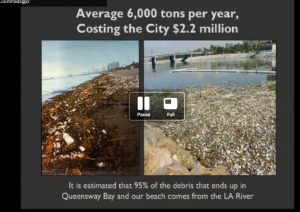Is this India? Mexico? No, it’s Long Beach, California after a rain. It’s what happens when the 51 miles of LA river channel washes whatever is in it into the Queensway Bay in Long Beach.
We don’t have to travel to one of the five ocean gyres where plastic swirls and chokes the life out of our marine animals; we can walk on water right here and spend millions cleaning it up. It gives new meaning to, “What a waste…”
The screen shot above came via the live stream of the TEDxGreatPacificGarbagePatch conference held in Long Beach, CA organized by the Plastic Pollution Coalition. The actual event had limited seating but anyone could attend virtually via house parties. Hopefully they’ll post the presentations for later replay.
As shocking as the above is to look at, the statistics on what we are doing to our oceans and LAND by using single use plastics and then throwing it away are scary. You don’t have to believe in climate change to see that we drastically need to change the way we relate to this pervasive pollutant.
A few of the not-so-fun facts from the conference:
• Over 2.4 million pounds of plastic are being dumped into our oceans EVERY HOUR.
• We’re losing 1 million apex animals every year because of them eating plastic and dying horrible deaths.
• Less than 5% of plastic is recycled.
• 40 governments and/or major municipalities representing 25% of the world’s population have BANNED the plastic bag. (California recently caved to the corporate money and kept plastic bags alive, but banning the bag will be put up for election again.)
Pretty grim, eh? And the pictures were worse, such as the picture of the sun bleached bones of a former camel lying in the sand — that was the only thing left, bones and the bushel basket size ball of plastic that the poor camel ingested earlier while raiding a garbage dump near Dubai.
The morning sessions left me pretty disgusted with myself and my fellow humans, for mucking things up so badly for all living things.
“Hope” came in the afternoon sessions, when more than one presenter named ‘women’ as part of the solution:
1. Women buy 85% consumer (weekly) items that are wrapped in single use plastic packaging.
2. As such we have the responsibility to educate each other on the issue and then…
3. Stop it. Just stop it. Quit buying anything with single-use plastic on it.
That’s what Beth Terry is doing (seen below). Because of Beth’s dedication to dropping her own consumption from the national average of about 100 pounds of consumer plastics per person per year to 3.7 pounds for her, she was asked to be part of this impressive line up that included Fabien Cousteau, Van Jones, Stacy Malkan, Ed Begley, Arlene Blum, Suja Lowenthal, H.E. John Dramani Mahama… go Beth!
As Beth pointed out, many plastic products don’t have to list what is in them, it’s up to the consumer to ask. If the companies don’t supply the answer don’t but the product. It’s better to be safe than sorry, the toxin BPA is now in 9 out of 10 newborns according to another speaker, Ken Cook.
Stacy Malkan, Co-founder of the Campaign for Safe Cosmetics called for a “Girlcott” — buying only what is good for you instead of boycotting what is bad. She went on to say that the government did get a Safe Cosmetics Act in place this year, but that isn’t enough. If we want change WE have to make the first move, “Show your passion and your outrage.”
There were so many excellent speakers. I wish I could quote them all.
Women have 54% of the electoral vote and 85% of the consumer ‘vote’. If the first vote doesn’t get action, use your second “voting” power and don’t buy what they are selling. Feel free to blog about what you bought and why.
As for cutting back, each year an average family uses 500 plastic grocery bags. If you need a place to start, start by carrying your own bags when you shop. That’s easy to do and those sturdy cloth bags are amazingly handy for more than groceries.
This post originally appeared on the blog In Women We Trust. You can contact the author at maryclarehunt@gmail.com

